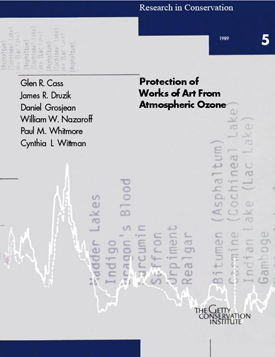
Protection of Works of Art from Atmospheric Ozone
Glen R. Cass, James R. Druzik, Daniel Grosjean, William W. Nazaroff, Paul M. Whitmore and Cynthia L. Wittman
1989
104 pages
PDF file size: 1.0 MB
Description
This is a summary of the full 284-page report of the Environmental Quality Laboratory, California Institute of Technology, Pasadena (Cass et al. 1988), on this three-year project.
The executive-summary format has been used to provide museum professionals, collectors, architects, and administrators with essential information that can be absorbed without specialized scientific training. The chapter on mathematical modeling of indoor pollutant concentration, briefly described in Chapter 4 of this report, has been appended unabridged from the original report since it constitutes one of the major findings and is a valuable tool for the planning of ventilation systems for buildings.
Table of Contents
- Foreword
- Ozone and the Fading of Artists Pigments
- Ozone Fading of Natural Organic Colorants
- Ozone as the Cause of Observed Fading Phenomena
- Measurements and Model Predictions of Ozone and Other Pollutant Concentrations
- Protection of Works of Art from Damage Due to Atmospheric Ozone
- Appendix: Mathematical Modeling of Chemically Reactive Pollutants in Indoor Air
- References
About the Authors
Glen R. Cass is associate professor of Environmental Engineering at the California Institute of Technology. Current research interests center on control of air pollution problems, including the problem of protection of works of art from damage due to atmospheric ozone.
James R. Druzik is a conservation scientist at the Getty Conservation Institute, where he coordinates extramural research. His research interests have related to all aspects of the museum environment, but center on the characterization and control of museum air pollution and materials damage.
Daniel Grosjean is president of DGA, a research-oriented environmental consulting company in Ventura, California, which he founded in 1983. Since 1979 he has also held an appointment as visiting associate, Department of Chemical Engineering, California Institute of Technology. Research interests include experimental studies in atmospheric chemistry and art conservation chemistry, with emphasis on reactive organic compounds.
William W. Nazaroff is assistant professor of Civil Engineering, University of California at Berkeley. He is interested in the experimental and theoretical aspects of indoor air quality, including the behavior of small particles, photo-oxidants, and control of radon exposure indoors.
Paul M. Whitmore joined the staff of the Environmental Quality Laboratory at the California Institute of Technology in 1984, and in 1986 he became assistant conservation scientist at the Center for Conservation and Technical Studies, Harvard University Art Museums. Subsequently he became director of the Research Center on the Materials of the Artist and Conservator, Mellon Institute, Pittsburgh.
Cynthia Wittman is pursuing graduate studies in chemical research.